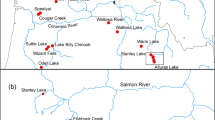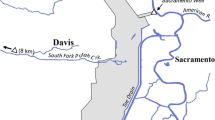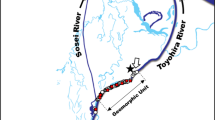Abstract
Aggregate hatchery production of Pacific salmon in the Kamchatka region of the Russian Federation is very low (< 0.5% of total harvest, with five hatcheries releasing approximately 41 M juvenile salmon annually), but contributions in certain rivers can be substantial. Enhancement programs in these rivers may strongly influence fitness and production of wild salmon. In this paper we document significant divergence in demographic traits in hatchery salmon populations in the Bolshaya River and we estimate the proportion of hatchery chum salmon in the total run in the Paratunka River to demonstrate the magnitude of enhancement in this system. We observed a reduction in the expression of life history types in hatchery populations (ranging from 1 to 9 types) compared to wild populations (17 types) of sockeye salmon in the Bolshaya River. We found similar trends in Chinook salmon in the same river system. This reduced life history diversity may make these fish less resilient to changes in habitat and climate. We estimate hatchery chum salmon currently contribute 17-45% to the natural spawning population in the Paratunka River. As hatchery fish increase in numbers at natural spawning sites, this hatchery production may affect wild salmon production. It is important to investigate the risk of introgression between hatchery and wild salmon that can lead to reduction in salmon fitness in Kamchatka rivers, as well as the potential of ecological interactions that can have consequences on status of wild salmon and overall salmon production in this region.









Similar content being viewed by others
Notes
The average catch of Kamchatka salmon (excluding pink salmon) in 2001–2007 was about 7 million fishes, and the average contribution of hatchery fish to the catch during this period was 30 thousand fishes, or approximately 0.43% of total catch.
References
Bernard RL, Myers K (1996) The performance of quantitative scale pattern analysis in the identification of hatchery and wild steelhead (Oncorhynchus mykiss). Can J Fish Aquat Sci 53:1727–1735
Buhle ER, Holsman KK, Scheuerell MD, Albaugh A (2009) Using an unplanned experiment to evaluate the effects of hatcheries and environmental variation on threatened populations of wild salmon. Biol Conservat 142(11):2449–2455
Burman P (1989) A comparative study of ordinary cross-validation, v-fold cross-validation and the repeated learning-testing methods. Biometrika 76(3):503–514
Chilcote MW, Goodson KW, Falcy MR (2011) Reduced recruitment performance in natural populations of anadromous salmonids associated with hatchery-reared fish. Can J Fish Aquat Sci 68:511–522
Davis ND (1987) Variable selection and performance of variable subsets in scale pattern analysis. International North Pacific Fisheries Commission Document. Vancouver, Canada. Available from Fisheries Research Institute, FRI-UW-8713. Seattle: University of Washington. 47 p
Groot C, Margolis L (1991) Pacific salmon life histories. UBC, Vancouver, 565 p
Heath DD, Devlin RH, Heath JW, Iwama GK (1994) Genetic, environmental and interaction effects on the incidence of backing in Oncorhynchus tshawytscha (Chinook salmon). Heredity 72(2):146–154
Heland M (1994) Flexibilite du developpementet migrations chez les Salmonides. Bull Soc Zool Fr 119(4):385
Hill MF, Botsford LW, Hastings A (2003) The effects of spawning age distribution on salmon persistence in fluctuating environments. J Anim Ecol 72(5):744–763
Imai N, Sagawa Y, Kudo H, Kaeriyama M (2007) A comparison of secondary sexual characters and age composition of wild and hatchery chum salmon (Oncorhynchus keta) in the Yurappu River, Southern Hokkaido in Japan. N Pac Anadr Fish Com Tech Rep 7:115–116
Ishida Y, Ito S, Kaeriyama M, McKinnell S, Nagasawa K (1993) Recent changes in age and size of chum salmon (Oncorhynchus keta) in the North Pacific Ocean and possible causes. Can J Fish Aquat Sci 50:290–295
Kaeriyama M (1998) Dynamics of chum salmon, Oncorhynchus keta, populations released from Hokkaido, Japan. N Pac Anadr Fish Com Bull 1:90–102
Kaev AM (2011) Wild and hatchery reproduction of pink and chum salmon and their catches in the Sakhalin-Kuril region, Russia. Env Biol Fish doi:10.1007/s10641-011-9900-5.
Kazakov RV (1997) A biological diversity and mechanisms of its maintenance at the Atlantic salmon. 1st Congress of Ichthyologists of Russia, Astrakhan', sent., 1997. Theses of reports. Moscow:VNIRO. P. 41 [in Russian]
Knudsen CM, Schroder SL, Busack CA, Johnston MV, Pearsons TN, Bosch WJ, Fast DE (2006) Comparison of life history traits between first-generation hatchery and wild upper Yakima River spring Chinook salmon. Trans Am Fish Soc 135:1130–1144
Koo TSY (1962) In: Koo TSY (ed) Age and growth studies of red salmon scales by graphical means. Studies of Alaska red salmon. University of Washington Press, Seattle, pp 53–12l
Kostow K (2009) Factors that contribute to the ecological risks of salmon and steelhead hatchery programs and some mitigating strategies. Rev Fish Biol Fish 19(1):9–31
Kudzina MA (2006) Assessment of hatchery salmon abundance in Bolshaya River basin using otolith marking data. Current Issues Facing Salmon Hatcheries in the Russian Far East: papers of the international science-practical workshop held in Ptropavlovsk-Kamchatsky, Russia on the 30th of November–1st of December 2006 as part of the VII scientific conference “Conservation of Kamchatka Marine and Terrestrial Biodiversity.” Petropavlovsk-Kamchatsky. Kamchatpres: 170–175. [In Russian]
Lichatowich J (1999) Salmon without rivers: a history of the Pacific salmon crisis. Island, Washington, 317 p
Markovsev VG (2010) Influence of hatchery salmon on wild populations in freshwater. Available from the Internet URL: http://www.stateofthesalmon.org/conference2010/downloads/Thurs_presentations/Session_5a_WestPac/Markovtsev.pdf
Naish KA, Taylor JE, Levin PS, Quinn TP, Winton JR, Huppert D, Hilborn R (2008) An evaluation of the effects of conservation and fishery enhancement hatcheries on wild populations of salmon. Adv Mar Biol 53:61–194
Plokhinsky NA (1980) Algorithms of biometrics. Moskow. MGU. 150 p. [in Russian]
Schindler DE, Hilborn R, Chasco B, Boatright CP, Quinn TP, Rogers LA, Webster MS (2010) Population diversity and the portfolio effect in an exploited species. Nature 465:609–612
Shannon CE (1948) A mathematical theory of communication. Bell System Technical Journal 27:379–423
Sviridov VV, Glebov II, Kulik VV (2004) Spatio-temporal variability of biological indicators of Pacific salmon in the Western part of the Bering sea. Izv. TINRO.138: 225–241. [in Russian]
Williams RN, Lichatowich JA, Mundy PR, Powell M (2003) Integrating artificial production with salmonid life history, genetic, and ecosystem diversity: a landscape perspective. Issue Paper for Trout Unlimited, West Coast Conservation Office, Portland. 4 September 2003. 84 p
Zaporozhets OM, Zaporozhets GV (1999) Differentiation of Pacific salmon stocks from scale structure: appropriate use of some two-dimensional parameters. The North Pacific Anadromous Fish Commission International Symposium: Recent Changes in Ocean Production of Pacific Salmon. November 1–2, 1999. Juneau, Alaska, USA. 84 p
Zaporozhets OM, Zaporozhets GV (2000a) Particularity and Prospects for Differentiating Wild and Hatchery Salmon Stocks from their Scale Structure Characteristics. Proceedings of Russian-American Conf. on Salmon Conservation: Interaction of wild and hatchery salmon. Khabarovsk, 2000. 64–65.
Zaporozhets OM, Zaporozhets GV (2000b) Using the coordinates of some character points of scales for differentiation of Pacific salmon stocks. N Pac Anadr Fish Comm Bull 2:325–329
Zaporozhets OM, Zaporozhets GV (2004) Interaction between hatchery and wild Pacific salmon in the Far East of Russia: a review. Rev Fish Biol Fish 14(3):305–319
Zhivotovsky LA, Fedorova LK, Rubtsova GA, Shitova MV, Rakitskaya TA, Prokhorovskaya VD, Smirnov BP, Kaev AM, Chupakhin VM, Samarsky VG, Pogodin VP, Borzov SI, Afanasiev KI (2011) Rapid expansion of an enhanced stock of chum salmon and its impacts on wild population components. Env Biol Fish. Online First, Springer.
Zubchenko AV (1997) The analysis of a condition and possible measures on restoration of structure of population of the Atlantic salmon of the Kola River. 1st Congresses of ichthyologists of Russia, Astrakhan', sent. 1997. Theses of reports. Moscow. VNIRO: 112. [in Russian]
Acknowledgements
The authors thank all who helped us with this study. We also wish to thank the translators and reviewers for their help in completing this manuscript. We extend gratitude to organizers of the 2010 State of the Salmon Conference, and we look forward to further scientific cooperation in this research area.
Author information
Authors and Affiliations
Corresponding author
Rights and permissions
About this article
Cite this article
Zaporozhets, O.M., Zaporozhets, G.V. Some consequences of Pacific salmon hatchery production in Kamchatka: changes in age structure and contributions to natural spawning populations. Environ Biol Fish 94, 219–230 (2012). https://doi.org/10.1007/s10641-011-9932-x
Received:
Accepted:
Published:
Issue Date:
DOI: https://doi.org/10.1007/s10641-011-9932-x




